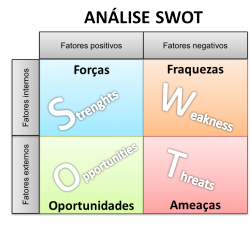SWOT stands for English terms Strengths (Forces), Weaknesses (Weaknesses), Opportunities (Opportunities) and Threats (Threats) consisting of a analysis tool quite popular in business.
In Business Administration, the SWOT Analysis is an important instrument used for strategic planning which consists of collecting important data that characterize the internal environment (strengths and weaknesses) and external (opportunities and threats) of the company.
THE SWOT Analysis it is a tool used to carry out environmental analysis, being the basis of management and strategic planning in a company or institution. Thanks to its simplicity, it can be used for any type of scenario analysis, from creating a blog to managing a multinational. This is an example of a simple system designed to position or verify the strategic position of the company/institution in the environment in question.
The SWOT analysis technique was developed by North American Albert Humphrey, during the development of a research project at Stanford University between the 1960s and 1970s, using data from the Fortune 500, a magazine that makes up a ranking of the largest companies Americans.
 The information referred to below must be classified in the SWOT categories for analysis of the company's scenario:
The information referred to below must be classified in the SWOT categories for analysis of the company's scenario:
- Strengths (forces) - internal advantages of the company in relation to competitors. E.g.: quality of the product offered, good customer service, financial strength, etc.
- Weaknesses (weaknesses) - internal disadvantages of the company in relation to competitors. E.g.: high production costs, bad image, inadequate installations, weak brand, etc.;
- Opportunities (opportunities) – positive external aspects that can enhance the company's competitive advantage. E.g.: changes in customer tastes, bankruptcy of a competitor, etc.;
- Threats (threats) - negative external aspects that can jeopardize the company's competitive advantage. E.g.: new competitors, loss of key workers, etc.
Cross Swat Analysis
The cross swot analysis consists of crossing the information from the four quadrants, in order to obtain a framework that allows the delineation of important strategies for the future of the company/institution.
For the SWOT Crusade analysis, it is first necessary to make a clear analysis of the environment, that is, to deeply research the strengths and weaknesses and know how to identify opportunities and threats. For each intersection, it is important to know how to create goals/strategies:
- Strengths x Opportunities = offensive strategy / development of competitive advantages.
- Strengths x Threats = confrontation strategy to change the environment in favor of the company.
- Weaknesses x Opportunities = reinforcement strategy to make better use of opportunities.
- Weaknesses x Threats = defensive strategy with possible deep modifications to protect the company.
See also the meaning of CRM.
